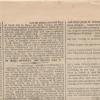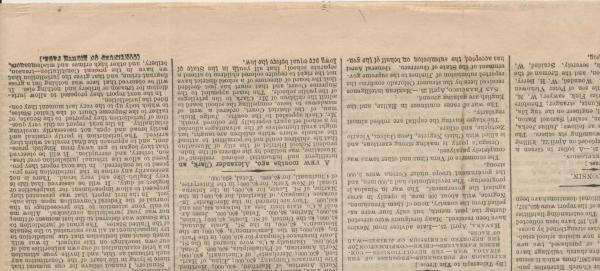The Courts and Slavery
| Grade | 9th -12th Grades | Class | U.S. History | Length of Lesson | 2-3 class periods |
| Lesson Title | The Courts and Slavery |
| Unit Title | Reconstruction and Civil Rights |
| Unit Compelling Question | |
| Historical Context: This short newspaper article, in the collection of the Muscatine Art Center, discusses a Supreme Court ruling in favor of Alexander Clark over the Independent School District of Muscatine. Prior to this ruling, Clark sued the Muscatine school board on behalf of his daughter, Susan, after he was told she could not attend the same school as white children. The Supreme Court ruled that all children in Iowa were equal before the law, and this landmark case ended school segregation in Iowa. With a job as a barber, Clark was able to meet influential white and black males of Muscatine, helping his voice be heard. He was also a friend of Fredrick Douglass during the 1840s. Muscatine became the largest African-American populated town in the state after many settled there after escaping the South or traveling eastward from other free states. Clark later established the African Methodists Episcopal Church in Muscatine, the first independent black domination in the United States. Clark was a fighter for civil rights and in 1855 signed a petition with state legislature that repealed a law that prohibited free blacks from entering the state. The repeal did not happen, and migration continued. Clark also fought for African-American right to vote and gained the right in 1868. For his children, Clark fought for equal education and sued his daughter's school after she was denied entrance due to her race. Clark won his Supreme Court case and as a result, Iowa became one of the first states to integrate schools. Clark was appointed U.S. Minister to Liberia by President Harrison in 1890, which became one of the highest-ranking appointments of an African-American by a president at that point of time. Clark died while in office of a fever in 1891. ### The United States is a Federal system. That means that the national government and state government have independent authority. With their roots as British colonies, the states created the national government after the American revolution. They gained certain powers but retained others to themselves. While the authority of the Federal government has grown tremendously in the past two centuries, there are still limits to what it can do. The states and Federal court systems are independent of each other. When there is a conflict, decisions by the Federal courts take overrule state judges. Iowa court records offer two excellent examples of that. The Ralph case was the first case to come before the Supreme Court when Iowa was a territory. The Iowa court ruled that, because Iowa did not allow slavery, a former slave who arrived here with the permission of his master was no longer a slave and could not be forced to return to slavery. However, the U.S. Supreme Court in the Dred Scott decision ruled that slaves were property of their masters wherever they lived and had no rights even to bring suit in court. It even said that Congress had no power to regulate slavery in any U.S. territory. While the Dred Scott decision became the law of the land officially, the Civil War soon "overturned" it by eliminating slavery everywhere. The legality of segregating schools on the basis of race showed also illustrated separate decisions between state and Federal courts. In the Clark case, the Iowa Supreme Court banned racial segregation in public schools. The U.S. Supreme Court sanctioned racial segregation as long as the schools were of equal quality. (In reality, black schools fell far short of the quality of white schools.) In all cases, decisions by the U.S. Supreme Court supersede any rulings by state courts of U.S. district courts. States may have additional restrictions to Federal requirements. For example, in modern times, some states try to restrict the right to abortion beyond what the U.S. Supreme Court allows in Roe v. Wade. Ultimately, however, it will be the Supreme Court that decides if state laws go too far to restrict a woman's right to control her reproduction. Without a final authority, there would be infinite confusion about what the laws say. |
|
| Lesson Supporting Question | |
| Lesson Overview | Students will learn about different court cases during the Civil War & Reconstruction that influenced how black people were viewed and treated in U.S.society. Students will break into groups with each group studying a different case and will work as a group to present what they have learned to the rest of the class. The lesson proceeds with class discussion, comparing and contrasting the court cases and analyzing what impacts they would have had on U.S. society. Students will know the results of other, earlier court cases: -Dred Scott v. Sanford -Clark v. Board of Directors -Montgomery v. Ralph -Plessy v. Ferguson
|
| Primary Sources Used |
|
| Resources Needed | https://www.ourdocuments.gov/doc.php?flash=false&doc=29 https://www.history.com/topics/black-history/plessy-v-ferguson https://iowamuseums.pastperfectonline.com/webobject/93AC800F-A983-4818-92B2-706178485540 http://uipress.lib.uiowa.edu/bdi/DetailsPage.aspx?id=62
|
| Standard | |
| Lesson Target | |
| Lesson Themes | Judicial System, African American Experience |
|
| Formative Assessment (How will you use the formative assessments to monitor and inform instruction?) |
|
| Summative Assessment (How does the lesson connect to planned summative assessment(s)?) |
| Author | Jess Larison | Created | Last Edited | ||||
| Reviewer: Dr. Lisa Millsaps, University of Northern Iowa | |||||||
| Lesson Plan Development Notes: Teaching Methods, University of Northern Iowa, Fall 2018 | |||||||


